MINISTRY OF CRAB, Colombo, Sri Lanka, 2019.12.16

Day 12 (3 of 3).
On our last evening of the trip, we had a few hours to spare in Colombo before heading to the airport. From online research, we learnt about the widely acclaimed seafood restaurant Ministry of Crab, which is famous for their giant lagoon crabs caught in the mangrove lagoons of Sri Lanka, and prepared in a selection of Asian cooking methods such as Sri Lankan pepper, Indian curry, Japanese garlic chilli, Singaporean chilli, etc. For decades, Sri Lankan lagoon crabs have been prized for their size and tasty meat. Almost all of the decent sized lagoon crabs (500g – 2kg) have been exported to Singapore (90%) and other parts of Asia and Europe. Ministry of Crab is one of the few restaurants in the nation that offers giant lagoon crabs, and has been named Asia’s 50 best restaurants for several years in a row. In less than ten years, the restaurant has expanded to Shanghai, Manila, Mumbai, Maldives, and Bangkok. The Ministry of Crab in Colombo is located at the Dutch Hospital Shopping Precinct, a retail complex housed in the oldest building compound in Colombo Fort, dated to 1681 in the Dutch Era. The Ministry of Crab is a success story of Dharshan Munidasa, the celebrity owner of the restaurant.
The success of Dharshan Munidasa exemplifies how Sri Lanka may find its footing in today’s world by absorbing techniques and cultures from other countries, promoting themselves on mass media, making use of the local natural resources, and gaining global recognition by competing on the international stage. Born in Tokyo from a Sri Lankan father and a Japanese mother, and graduated in The Johns Hopkins University in the United States, Dharshan Munidasa returned to Sri Lanka in 1994. He came back with his Japanese cooking techniques and American way of thinking, and opened his Japanese restaurant Nihonbashi in 1995 and then Ministry of Crab in 2011, both have subsequently become the first Sri Lankan restaurants made to the list of Asia’s 50 Best Restaurants. Munidasa appeared on BBC Rick Stein’s program in 2009, then in 2010, Munidasa produced and hosted a culinary travel show called “Culinary Journey’s with Dharshan” on Sri Lanka’s ETV. He has also featured on Nippon Shokudo for TV Tokyo, and Anthony Bourdain’s Parts Unknown on CNN.
While the fascinating Buddhist moments in Anuradhapura and Polonnaruwa showcase the cultural heritage of Sri Lanka, and the colonial legacies in the Hill Country and South Coast reveal the nation’s difficult first encounter with the West, Munidasa’s Ministry of Crab on the other hand demonstrates how a contemporary Sri Lankan identity is taking shape and how a new culture can be confidently exported to the outside world. From Anuradhapura to the Ministry of Crab in Colombo, we felt that we had gone through a 2000-year chronicle of Sri Lanka in a matter of 12 days.
 The old Colombo Lighthouse or Clock Tower was a lighthouse in Colombo and still serves as a clock tower today. It signifies the bygone era of colonial Ceylon.
The old Colombo Lighthouse or Clock Tower was a lighthouse in Colombo and still serves as a clock tower today. It signifies the bygone era of colonial Ceylon.
 Now converted into a popular shopping and dining venue in downtown Colombo, the Old Colombo Dutch Hospital is considered to be the oldest building in Colombo Fort.
Now converted into a popular shopping and dining venue in downtown Colombo, the Old Colombo Dutch Hospital is considered to be the oldest building in Colombo Fort.
 In the era of commercialism, Christmas is celebrated in Metropolitan Colombo despite the nation’s Buddhist background.
In the era of commercialism, Christmas is celebrated in Metropolitan Colombo despite the nation’s Buddhist background.
 Just two blocks west of the Dutch Hospital lies an enormous construction site: 269 hectares of reclaimed land in the Indian Ocean designated for Port City, an ambitious construction project targeted to establish a new central business district with glassy towers that resemble a small Singapore. The $1.4bn Chinese state-owned investment has been controversial: non transparent contract agreement between investors and the former Sri Lankan president Rajapaksa, environmental impact of the massive land reclamation including potential damage on the fishing industry and burden on the limited natural resources to sustain the new downtown, and the unclear operation plan in the future.
Just two blocks west of the Dutch Hospital lies an enormous construction site: 269 hectares of reclaimed land in the Indian Ocean designated for Port City, an ambitious construction project targeted to establish a new central business district with glassy towers that resemble a small Singapore. The $1.4bn Chinese state-owned investment has been controversial: non transparent contract agreement between investors and the former Sri Lankan president Rajapaksa, environmental impact of the massive land reclamation including potential damage on the fishing industry and burden on the limited natural resources to sustain the new downtown, and the unclear operation plan in the future.
 In the midst of bustling commercial activities of downtown Colombo lies the peaceful courtyards of the Dutch Hospital, where the Ministry of Crab is situated. At the restaurant entrance, a display menu shows visitors the size range of local lagoon crabs (500g – 2kg) and prawns (150g to 500g+).
In the midst of bustling commercial activities of downtown Colombo lies the peaceful courtyards of the Dutch Hospital, where the Ministry of Crab is situated. At the restaurant entrance, a display menu shows visitors the size range of local lagoon crabs (500g – 2kg) and prawns (150g to 500g+).
 We left our luggage at the reception and sat down at our reserved table.
We left our luggage at the reception and sat down at our reserved table.
 There were foreign visitors and expats as well as local business people in the restaurant.
There were foreign visitors and expats as well as local business people in the restaurant.
 The restaurant is causal and pleasant, and decorated with the orange theme colour.
The restaurant is causal and pleasant, and decorated with the orange theme colour.
 From floral arrangement to dining utensil, everything in the restaurant was cheerful.
From floral arrangement to dining utensil, everything in the restaurant was cheerful.
 Prawns of different sizes were on display.
Prawns of different sizes were on display.
 We started the meal with giant prawns.
We started the meal with giant prawns.
 As well as king prawn bisque.
As well as king prawn bisque.
 Then we finished the meal with two giant lagoon crabs, one made with Sri Lankan pepper sauce and the other garlic chilli. They were perhaps the most tasty crabs we had for a long long time.
Then we finished the meal with two giant lagoon crabs, one made with Sri Lankan pepper sauce and the other garlic chilli. They were perhaps the most tasty crabs we had for a long long time.
 After dinner at 21:15, we had trouble locating our online pre-booked cab at the Dutch Hospital. A restaurant staff helped us to talk on phone with the driver to resolve the issue. We ended up finding the right car behind the restaurant. At the departure concourse in the airport, we once again passed by the advertisement of Ministry of Crab, the same one that we saw 12 days ago. What a satisfying meal and a fruitful journey! This concludes our December 2019 journey to Sri Lanka.
After dinner at 21:15, we had trouble locating our online pre-booked cab at the Dutch Hospital. A restaurant staff helped us to talk on phone with the driver to resolve the issue. We ended up finding the right car behind the restaurant. At the departure concourse in the airport, we once again passed by the advertisement of Ministry of Crab, the same one that we saw 12 days ago. What a satisfying meal and a fruitful journey! This concludes our December 2019 journey to Sri Lanka.
LEGACY OF A 400-YEAR COLONIAL FORT, Galle, Sri Lanka, 2019.12.16

Day 12 (1 of 3).
Known as Asia’s largest remaining colonial fortress and an UNESCO World Heritage site, Galle is a popular tourist destination in southwest Sri Lanka. Galle has long been an important trading port of the island since ancient times. Cinnamon was exported from Sri Lanka as early as 1400 BC, and Galle was likely the main port of export. Throughout history, Galle traded with the Greeks, Romans, Persians, Chinese, Arabs, Malays, and Indians. Sri Lanka’s colonial history began when the Portuguese arrived in the 16th century and built a fortified city in Galle. Galle continued to serve as the main port for spices export. In 1640, the Portuguese surrendered to the Dutch East India Company. After the takeover, the Dutch built the fort that we saw today with bastions and a solid granite wall. In 1796, Galle and Sri Lanka changed hands again when the island became a British Crown colony named Ceylon. The 400-year colonial rule came to an end in 1948 when independence was granted to establish Dominion of Ceylon in the Commonwealth. Then 28 years later in 1972, Sri Lanka finally became a republic. From four centuries as a colonial port of export for spices and coffee (then replaced by tea) to a tourist town based on commercialization of its colonial past, Galle’s fortune has always been tied with the outside world.
 We dropped off our backpacks at the baggage storage in Galle Railway Station, then found our way into the old fortified city.
We dropped off our backpacks at the baggage storage in Galle Railway Station, then found our way into the old fortified city.
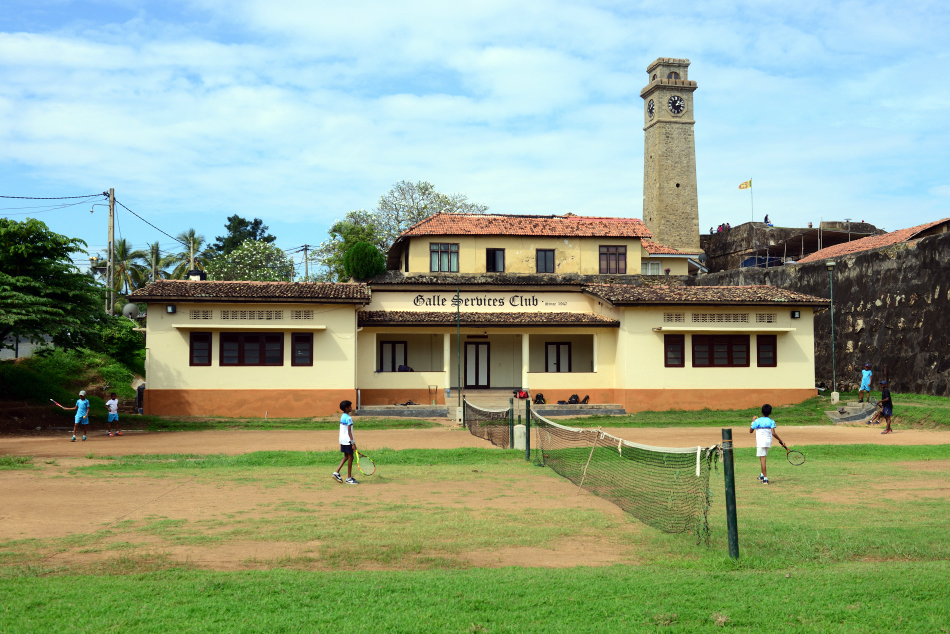 The first thing we saw inside the fortress was Galle Services Club (est. 1947) and the 1883 clock tower.
The first thing we saw inside the fortress was Galle Services Club (est. 1947) and the 1883 clock tower.
 Located on the highest point in the fortress, the Dutch Reformed Church (Groote Kerk) was built by the Dutch in 1755. It was the third Dutch Reformed church in Galle and signified the rise of the Dutch after the Portuguese.
Located on the highest point in the fortress, the Dutch Reformed Church (Groote Kerk) was built by the Dutch in 1755. It was the third Dutch Reformed church in Galle and signified the rise of the Dutch after the Portuguese.
 Further down the road from the Dutch Reformed Church stands All Saints’ Church, Galle’s first Anglican Church (consecrated in 1871) and a powerful statement by the British.
Further down the road from the Dutch Reformed Church stands All Saints’ Church, Galle’s first Anglican Church (consecrated in 1871) and a powerful statement by the British.
 The former Dutch warehouse from the 17th century has become the National Maritime Archaeology Museum.
The former Dutch warehouse from the 17th century has become the National Maritime Archaeology Museum.
 In 1796, the British relocated the emblem of the Dutch East India Company from the outer gate to the inner, and put up the British Royal Emblem at the outer gate.
In 1796, the British relocated the emblem of the Dutch East India Company from the outer gate to the inner, and put up the British Royal Emblem at the outer gate.
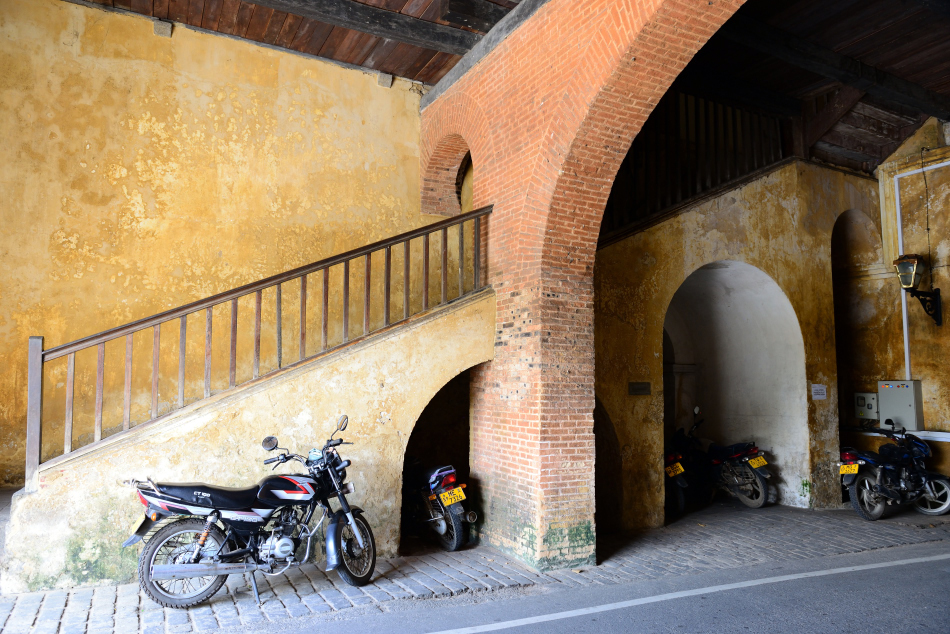 The interior of the old gate is used for motorcycle parking.
The interior of the old gate is used for motorcycle parking.
 First built by the Portuguese, then renamed to Zwart Fort (Black Fort) by the Dutch. We accessed the Black Fort via a police compound. At Zwart Fort, a staff came out to show us around and told us about the history of the place.
First built by the Portuguese, then renamed to Zwart Fort (Black Fort) by the Dutch. We accessed the Black Fort via a police compound. At Zwart Fort, a staff came out to show us around and told us about the history of the place.
 The Old Dutch Hospital was established by the Dutch to look after the staff of the Dutch East India Company. Then the British extended the building and converted it into a barracks. After independence, the building was used as the town hall. In 2014, the building was once again converted into a shopping and dining complex.
The Old Dutch Hospital was established by the Dutch to look after the staff of the Dutch East India Company. Then the British extended the building and converted it into a barracks. After independence, the building was used as the town hall. In 2014, the building was once again converted into a shopping and dining complex.
 Meeran Jumma Masjid looks more like a church than a mosque, but this Islamic prayer hall has been around for 300 years already. More than half of the population inside the fort are Moor. They are believed to be descendants of the Arab traders who settled in Sri Lanka at around the 9th century.
Meeran Jumma Masjid looks more like a church than a mosque, but this Islamic prayer hall has been around for 300 years already. More than half of the population inside the fort are Moor. They are believed to be descendants of the Arab traders who settled in Sri Lanka at around the 9th century.
 Galle Fort is built on a rock peninsula and there are a few small beaches near the lighthouse.
Galle Fort is built on a rock peninsula and there are a few small beaches near the lighthouse.
 The Galle Lighthouse is the oldest light station in the nation. The original was built by the British in 1848 but was destroyed by fire in 1936. The current 26.5m tall lighthouse was constructed in 1939.
The Galle Lighthouse is the oldest light station in the nation. The original was built by the British in 1848 but was destroyed by fire in 1936. The current 26.5m tall lighthouse was constructed in 1939.
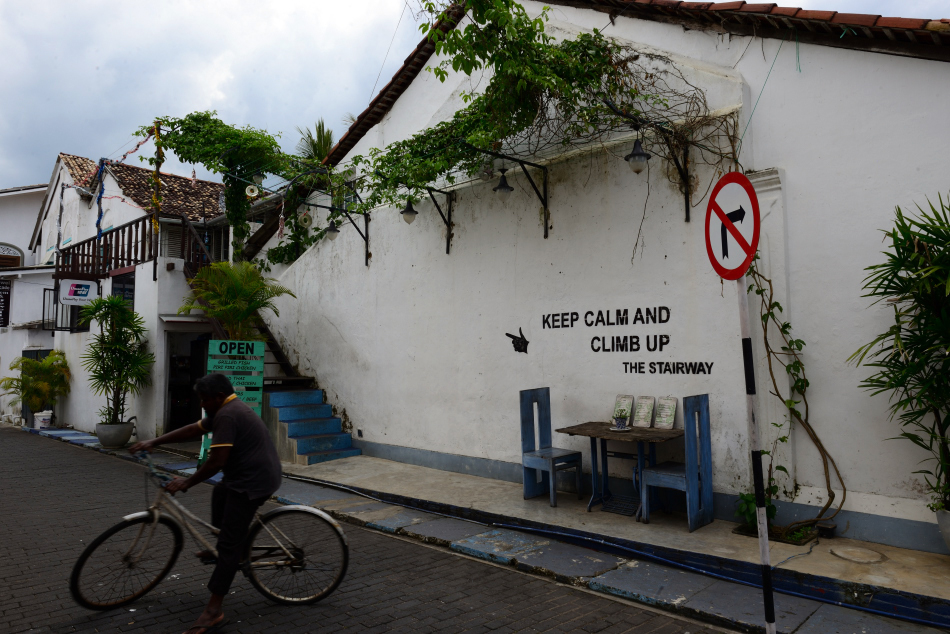 Strolling or cycling aimlessly within Galle Fort is a nice way to explore the town.
Strolling or cycling aimlessly within Galle Fort is a nice way to explore the town.
 In Galle Fort, Dairy King icecream has been recommended by a number of guidebooks and blogs.
In Galle Fort, Dairy King icecream has been recommended by a number of guidebooks and blogs.
 Dairy King is a great place to take a short break during a visit to Galle Fort.
Dairy King is a great place to take a short break during a visit to Galle Fort.
 Many houses in Galle Fort have been converted into guesthouses, restaurants, or shops catered for tourists.
Many houses in Galle Fort have been converted into guesthouses, restaurants, or shops catered for tourists.
 The ambience of the colonial times is the top selling point for the tourist industry in Galle.
The ambience of the colonial times is the top selling point for the tourist industry in Galle.
 Some old mansions are transformed into high end retail shops for fabrics, furniture, housewares, and other design items with a twist of Sri Lankan style.
Some old mansions are transformed into high end retail shops for fabrics, furniture, housewares, and other design items with a twist of Sri Lankan style.
 Established in 1892, Al Bahajathul Ibraheemiyyah Arabic College is one of the oldest Islamic Arabic institutions in Sri Lanka.
Established in 1892, Al Bahajathul Ibraheemiyyah Arabic College is one of the oldest Islamic Arabic institutions in Sri Lanka.
 On our way out of the fort, we passed by Sri Sudharmalaya Buddhist Temple, a Buddhist temple with a unique appearance. The temple dated back to 1889. The belfry of the building suggests that temple might be converted from an earlier church.
On our way out of the fort, we passed by Sri Sudharmalaya Buddhist Temple, a Buddhist temple with a unique appearance. The temple dated back to 1889. The belfry of the building suggests that temple might be converted from an earlier church.
MIRISSA HILLS CINNAMON PLANTATION, Mirissa, Sri Lanka, 2019.12.15

Day 11 (2 of 2).
Cinnamomum verum, or true cinnamon tree, is an evergreen tree native to Sri Lanka. Considered as the better tasting and has more health benefits than the other types of cinnamon cultivated elsewhere in Asia and Africa, the inner bark of Cinnamomum verum has been a precious commodity sought after by the West since colonial times. Sri Lanka nowadays exports roughly 85-90% of the world’s true cinnamon. Spice plantations can be found in many parts of the island, including the South Coast.
We stayed at Mirissa Hills, a working cinnamon plantation near Mirissa, for two nights. At the plantation, there are three buildings that offer guest accommodation. We stayed at a building called the “Museum”, a work-in-progress cinnamon museum. At Mirissa Hills, we got a chance to join a plantation tour to learn more about cinnamon production.
 Our room was located at the “Museum” building, around halfway up the hill of the plantation estate.
Our room was located at the “Museum” building, around halfway up the hill of the plantation estate.
 Inside the “Museum”building, four guestrooms are allocated on both sides of the courtyard.
Inside the “Museum”building, four guestrooms are allocated on both sides of the courtyard.
 Despite the age of the building, our room was quite comfortable.
Despite the age of the building, our room was quite comfortable.
 The main building, Mount Cinnamon, is located 5 minutes walk uphill from the Museum. Designed by architect C. Anjalendran, Mount Cinnamon is an hidden architectural gem in the midst of dense vegetation.
The main building, Mount Cinnamon, is located 5 minutes walk uphill from the Museum. Designed by architect C. Anjalendran, Mount Cinnamon is an hidden architectural gem in the midst of dense vegetation.
 Served as an apprentice of architectural master Geoffrey Bawa, C. Anjalendran is a leading architect of today’s Sri Lanka. At Mount Cinnamon, C. Anjalendran arranges the guestrooms around the courtyard and swimming pool.
Served as an apprentice of architectural master Geoffrey Bawa, C. Anjalendran is a leading architect of today’s Sri Lanka. At Mount Cinnamon, C. Anjalendran arranges the guestrooms around the courtyard and swimming pool.
 The common room in Mount Cinnamon is dominated by Laki Senanayake’s sculpture “Enchanted Forest”.
The common room in Mount Cinnamon is dominated by Laki Senanayake’s sculpture “Enchanted Forest”.
 Laki Senanayake worked as an assistant to architect Geoffrey Bawa, and created a number of sculptures and murals for Bawa’s buildings.
Laki Senanayake worked as an assistant to architect Geoffrey Bawa, and created a number of sculptures and murals for Bawa’s buildings.
 Outside the common room, the covered veranda was where we had breakfast and dinner.
Outside the common room, the covered veranda was where we had breakfast and dinner.
 The two dogs of the estate often lingered around the veranda. One of the dogs is already 16 years old.
The two dogs of the estate often lingered around the veranda. One of the dogs is already 16 years old.
 The pavilion in the backyard served as the dancing stage for peacocks to attract other peahens.
The pavilion in the backyard served as the dancing stage for peacocks to attract other peahens.
 After breakfast, we walked over to a covered veranda serving as a gallery for sculpture and artwork.
After breakfast, we walked over to a covered veranda serving as a gallery for sculpture and artwork.
 Seeing such an interesting collection of artwork was a great surprise for us.
Seeing such an interesting collection of artwork was a great surprise for us.
 In the second afternoon just before most staff called it a day, we followed the manager for a cinnamon tour. The manager showed us cinnamon trees of different sizes and ages. The cinnamon trees were virtually everywhere in the estate: by the road, behind the buildings, on the hill slope, etc., just that we didn’t notice them until the tour.
In the second afternoon just before most staff called it a day, we followed the manager for a cinnamon tour. The manager showed us cinnamon trees of different sizes and ages. The cinnamon trees were virtually everywhere in the estate: by the road, behind the buildings, on the hill slope, etc., just that we didn’t notice them until the tour.
 At the factory, a staff showed us how to remove the bark of the cinnamon branch.
At the factory, a staff showed us how to remove the bark of the cinnamon branch.
 The bark rolls were then placed over our heads for drying.
The bark rolls were then placed over our heads for drying.
 From 1970 to now, international production of cinnamon has grown more than tenfold. It is hard to imagine that such popular spice could still be processed in such a simple and traditional manner. Such production method in Sri Lanka hasn’t changed much in the past few centuries.
From 1970 to now, international production of cinnamon has grown more than tenfold. It is hard to imagine that such popular spice could still be processed in such a simple and traditional manner. Such production method in Sri Lanka hasn’t changed much in the past few centuries.
 In the morning of December 16th, Mirissa Hills arranged a car to drop us at Galle.
In the morning of December 16th, Mirissa Hills arranged a car to drop us at Galle.
 We passed by a series of beaches near Weligama. Occasionally we would see empty stilts near the shore. The traditional fishermen that Steve McCurry encountered in the mid 1990s were long gone. Today, the stilts are mainly for tourist to take selfies or locals to mimic their the bygone fishermen and let tourists to photograph them for a fee.
We passed by a series of beaches near Weligama. Occasionally we would see empty stilts near the shore. The traditional fishermen that Steve McCurry encountered in the mid 1990s were long gone. Today, the stilts are mainly for tourist to take selfies or locals to mimic their the bygone fishermen and let tourists to photograph them for a fee.
 Most beaches were empty except occasional surfers. Half day in Galle and a dinner in Colombo would make up the last day of our Sri Lankan journey.
Most beaches were empty except occasional surfers. Half day in Galle and a dinner in Colombo would make up the last day of our Sri Lankan journey.
IN SEARCH OF WHALES, Mirissa, Sri Lanka, 2019.12.15

Day 11 (1 of 2).
Mirissa is known as the best location for whale watching in Sri Lanka. In recent years, it is also considered as one of the world’s best spot for blue whale sighting. Doing a whale watching tour was one of the main reasons for us to visit Mirissa. While marketed as a special place in the world to have a good chance to see the blue whales, there are also opportunity to see fin whales, sei whales, sperm whales, bryde’s whales, orcas, dolphins, flying fish, turtles, manta rays, whale sharks, etc. just several miles out from Mirissa. There is never a 100% guarantee of sighting, but it is the expectation of seeing these elusive marine mammals that drives the multi billion marine tourism industry to grow rapidly around the world, including at Mirissa.
Mirissa was our second ever whale watching cruise after our wonderful orca encounter in Hokkaido, Japan six months prior. This time, weather was much warmer in tropical Sri Lanka, but the water of Indian Ocean was significantly rougher, and we spent much longer in the sea. While we didn’t hit the jackpot and see the blue whale, we did saw a fin whale, several groups of dolphins and a sea turtle in the 7-hour journey out in the sea.
 At 5:55, a tuk tuk came to our hotel Mirissa Hills to pick us up. We were dropped at the office of Raja and the Whales to pay for the tour, and then followed the group to the dock.
At 5:55, a tuk tuk came to our hotel Mirissa Hills to pick us up. We were dropped at the office of Raja and the Whales to pay for the tour, and then followed the group to the dock.
 At the dock, tourist boats from different companies were getting ready for the sail at 6:30am.
At the dock, tourist boats from different companies were getting ready for the sail at 6:30am.
 During the first half of the cruise we passed by a number of fishing boats.
During the first half of the cruise we passed by a number of fishing boats.
 The weather wasn’t perfect and the sea was rough at times.
The weather wasn’t perfect and the sea was rough at times.
 Given the occasional rough conditions of the ocean, some fishing boats looked overly simple to us.
Given the occasional rough conditions of the ocean, some fishing boats looked overly simple to us.
 Apart from fishing vessels, we also saw large container ships in the distant horizon.
Apart from fishing vessels, we also saw large container ships in the distant horizon.
 At about halfway of the journey, most tourists had their eyes closed to battle seasickness.
At about halfway of the journey, most tourists had their eyes closed to battle seasickness.
 While we worried that the day might turn out fruitless, we finally had a brief encounter of a fin whale.
While we worried that the day might turn out fruitless, we finally had a brief encounter of a fin whale.
 While it was difficult to determine the actual size of the animal, fin whale is in fact the second largest whale in the world, just after the blue whale.
While it was difficult to determine the actual size of the animal, fin whale is in fact the second largest whale in the world, just after the blue whale.
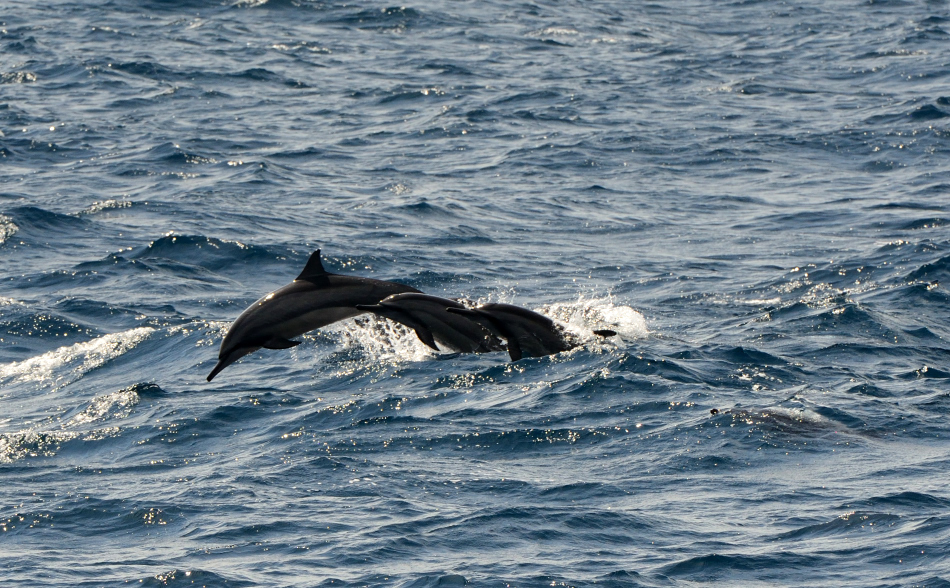 Throughout the day, we had several encounters of dolphins.
Throughout the day, we had several encounters of dolphins.
 For most of the times, we saw the dolphins in groups of about a dozen or more.
For most of the times, we saw the dolphins in groups of about a dozen or more.
 Most dolphins we saw were leaping in and out of the water in high speed.
Most dolphins we saw were leaping in and out of the water in high speed.
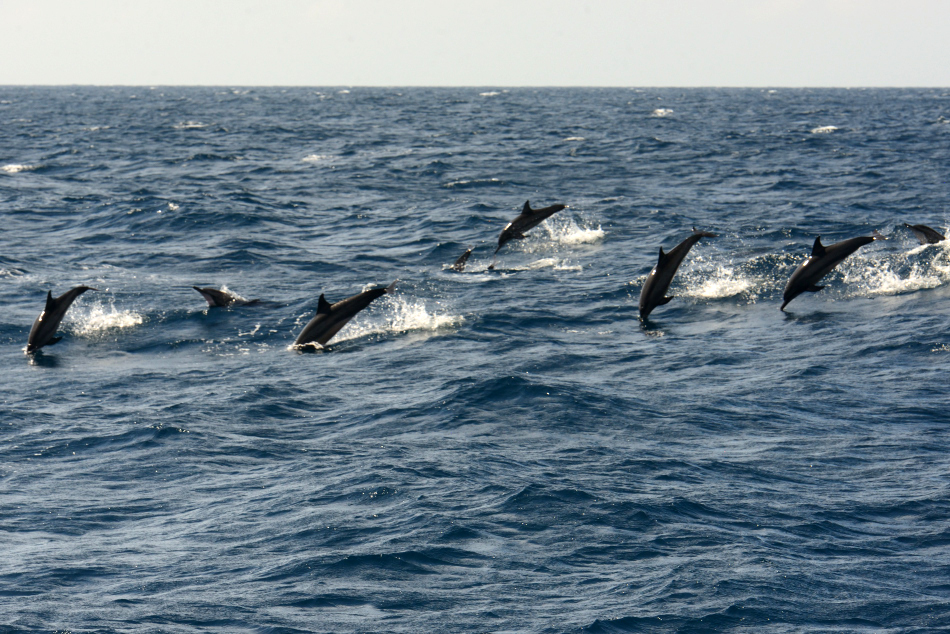 My own photos were limited by the zoom extent of my camera lens.
My own photos were limited by the zoom extent of my camera lens.
 After the journey, Raja sent us close up photos taken by a staff during the trip.
After the journey, Raja sent us close up photos taken by a staff during the trip.
 The staff even captured the twisting jump of a dolphin.
The staff even captured the twisting jump of a dolphin.
 As well as a sea turtle swimming near the surface.
As well as a sea turtle swimming near the surface.
 It was after noontime by the time we returned to the pier.
It was after noontime by the time we returned to the pier.
 The day was getting hotter at the dock.
The day was getting hotter at the dock.
 Walking back to the town, we passed by the office of Raja and the Whales again.
Walking back to the town, we passed by the office of Raja and the Whales again.
PARADISE BY THE INDIAN OCEAN, Mirissa, Sri Lanka, 2019.12.14

Day 10 (2 of 2).
In 1995, world renounced photographer Steve McCurry immortalized the South Coast of Sri Lanka with his iconic photograph Stilt Fishermen, capturing four local fishermen sitting on wooden stilts and fishing at the shore of Weligama. The mid-1990s also marked the beginning of tourism at the fishing town of Weligama and the adjacent Mirissa. Mirissa, historically known as the south’s largest fishing port for tuna, mullet, snapper and butterfish, was soon developed into a paradise-like holiday destination. Between Mirissa and Weligama, there are plenty of pristine beaches, decent seafood restaurants, accommodations of all sorts, good surfing spots, hidden coves for snorkeling with sea turtles, and the world famous whale watching waters. The Sri Lankan South Coast has all the essentials of a tropical holiday destination except the large partying crowds like Full Moon parties at Koh Phangan in Thailand. In fact, in Sri Lanka alcohol is prohibited during Uposatha, or the full moon days. Despite the lack of vibrant nightlife and the destructions and loss of lives caused by the 2004 Indian Ocean Tsunami, tourism in Mirissa and the South Coast continues to thrive solely because of the area’s natural beauty.
Many travelers prefer to stay in the South Coast for days if not weeks, especially if one is interested in surfing. We didn’t have such luxury in terms of time, but could only spare two days to chill out by the sea, including a 7-hour boat ride out in the rough waters to seek for marine mammals.
 Beautiful, laid back, and has plenty of space to just sit down to enjoy a fresh coconut drink, Mirissa Beach should meet most people’s expectations.
Beautiful, laid back, and has plenty of space to just sit down to enjoy a fresh coconut drink, Mirissa Beach should meet most people’s expectations.
 The quality of both the sand and water at Mirissa Beach is top notch.
The quality of both the sand and water at Mirissa Beach is top notch.
 Just months after the terrorist attacks in Colombo and Negombo, the number of foreign visitors might not match the previous year. Nonetheless, the beach was filled with the laughter of local beachgoers.
Just months after the terrorist attacks in Colombo and Negombo, the number of foreign visitors might not match the previous year. Nonetheless, the beach was filled with the laughter of local beachgoers.
 The Parrot Rock Bridge, a rock island accessible by a short walk in shallow water, is an iconic feature in Mirissa Beach.
The Parrot Rock Bridge, a rock island accessible by a short walk in shallow water, is an iconic feature in Mirissa Beach.
 Climbing the Parrot Rock Bridge allowed us to have an overview of Mirissa Beach.
Climbing the Parrot Rock Bridge allowed us to have an overview of Mirissa Beach.
 The Mirissa Beach is one of the many resort beaches in the South Coast of Sri Lanka. In fact, the entire South Coast of Sri Lanka has a series of fine beaches along the Indian Ocean.
The Mirissa Beach is one of the many resort beaches in the South Coast of Sri Lanka. In fact, the entire South Coast of Sri Lanka has a series of fine beaches along the Indian Ocean.
 Two bays east of Mirissa Beach, we arrived at Coconut Tree Hill, a small peninsula topped with a grove of coconut trees that was made famous in recent years by Instagram users and online bloggers who post selfies taken from the hill.
Two bays east of Mirissa Beach, we arrived at Coconut Tree Hill, a small peninsula topped with a grove of coconut trees that was made famous in recent years by Instagram users and online bloggers who post selfies taken from the hill.
 Despite the poor weather, the Coconut Tree Hill was nonetheless a lovely place for us to enjoy a panoramic view of the surrounding beaches.
Despite the poor weather, the Coconut Tree Hill was nonetheless a lovely place for us to enjoy a panoramic view of the surrounding beaches.
 All tourists chose to stand at the centre of Coconut Tree Hill to take selfies with the sea as the background.
All tourists chose to stand at the centre of Coconut Tree Hill to take selfies with the sea as the background.
 There is a local old man lingering around the Coconut Tree Hill. He loves to interact with tourists and showed them good spots for photo shooting.
There is a local old man lingering around the Coconut Tree Hill. He loves to interact with tourists and showed them good spots for photo shooting.
 In the evening, most tourists sat down at the outdoor restaurants along the beach, while the locals continued to have fun in the waves.
In the evening, most tourists sat down at the outdoor restaurants along the beach, while the locals continued to have fun in the waves.
 The last moment of sunlight created a dramatic moment at Mirissa Beach.
The last moment of sunlight created a dramatic moment at Mirissa Beach.
 The locals refused to leave despite it was getting really dark.
The locals refused to leave despite it was getting really dark.
 A group of locals requested us to take a photo of them.
A group of locals requested us to take a photo of them.
 In the evening, most tourists would sit down at a beach restaurant for a seafood dinner.
In the evening, most tourists would sit down at a beach restaurant for a seafood dinner.
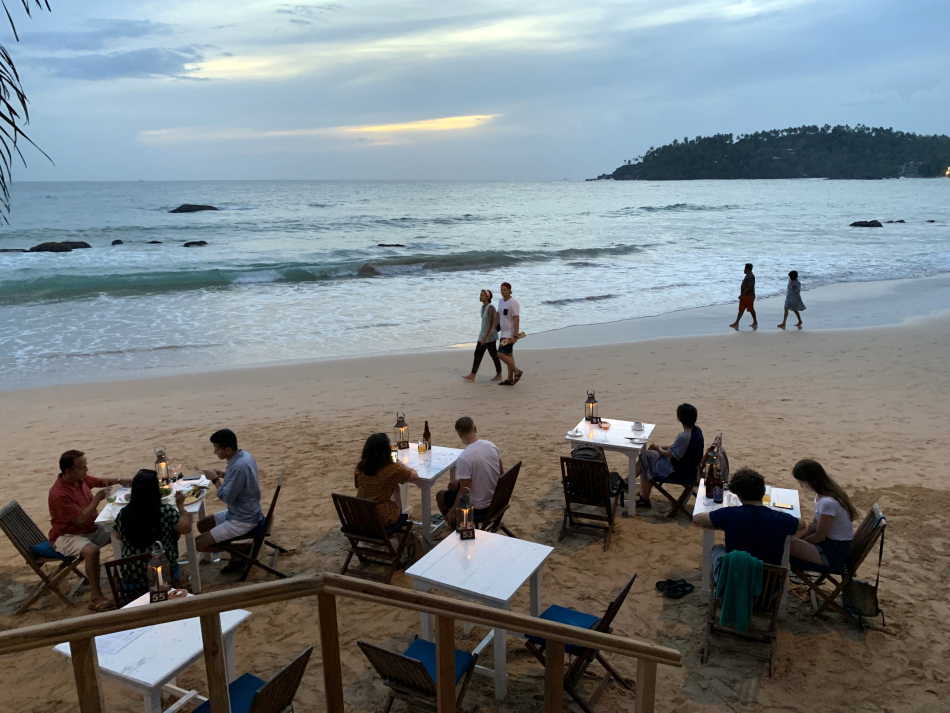 We picked Zephyr Restaurant & Bar near Parrot Rock Bridge for dinner.
We picked Zephyr Restaurant & Bar near Parrot Rock Bridge for dinner.
 The staff at Zephyr brought out a plate of catches of the day for us to choose.
The staff at Zephyr brought out a plate of catches of the day for us to choose.
 We sat down at a table on the beach.
We sat down at a table on the beach.
 One of us picked lobster as the main dish.
One of us picked lobster as the main dish.
 Another main dish we ordered was a grilled spangled emperor fish. Fresh and great ambience.
Another main dish we ordered was a grilled spangled emperor fish. Fresh and great ambience.
MORNING SAFARI, Udawalawe National Park, Sri Lanka, 2019.12.14

Day 10 (1 of 2).
There are 26 national parks in Sri Lanka, covering an area of 5,734 km², or slightly less than 9% of the country. As a small nation, Sri Lanka has a diverse range of wildlife, from marine mammals to other big game. The island also has one of the highest rates of biological endemism (16% of the fauna and 23% of flowering plants are endemic) in the world. Having a chance to see Sri Lanka’s precious wildlife in its natural habitat should be a highlight for all visitors.
With several elephant and even one leopard sightings in our first drive, any wildlife that we saw in our second safari was a bonus. Nonetheless, it was a pleasant experience to venture into the open wilderness early in the morning, when the air was cool and birds were at their most active. As the day warmed up after 8am, most animals seemed to be hiding in the shade somewhere, except occasional elephants that were looking for other ways to cool themselves down. The morning safari was the final act for us before moving on to the South Coast.
 Udawalawe Reservoir appeared in total tranquility at 6am.
Udawalawe Reservoir appeared in total tranquility at 6am.
 Again our jeep passed through the Udawalawe Reservoir before entering the park.
Again our jeep passed through the Udawalawe Reservoir before entering the park.
 Our morning safari began with the sighting of a golden jackal. In both Hindu and Buddhist cultures, jackals are considered an intelligent and cunning animals.
Our morning safari began with the sighting of a golden jackal. In both Hindu and Buddhist cultures, jackals are considered an intelligent and cunning animals.
 In a safari national park, one of the easiest places to spot wildlife is the vehicular path because of the lack of vegetation.
In a safari national park, one of the easiest places to spot wildlife is the vehicular path because of the lack of vegetation.
 A group of birds came together for morning choir. Early morning, according to our driver, is the best time for birding.
A group of birds came together for morning choir. Early morning, according to our driver, is the best time for birding.
 At the top of a tree, we spotted a pair of malabar pied hornbills. Malabar pied hornbills are omnivorous. Their diet ranges from fruits to small animals and insects.
At the top of a tree, we spotted a pair of malabar pied hornbills. Malabar pied hornbills are omnivorous. Their diet ranges from fruits to small animals and insects.
 An adult female white bellied sea eagle can measure up to 90cm, with a wingspan of up to 2.2m long.
An adult female white bellied sea eagle can measure up to 90cm, with a wingspan of up to 2.2m long.
 Due to their high reproductive rate, good adaptability in different environments, and the diminishing of their natural predators such as leopards, jackals, mongooses, pythons, monitor lizards and eagles because of human activities, the population of peafowls has grown rapidly throughout the island. With frequent damages to agricultural crops, the peafowls have become a headache for Sri Lankan farmers. On the other hand, peafowls have considerably cultural significance for the Buddhist and Hindu, thus a protected species in Sri Lanka despite of their impact to the farmers. For the Sinhalese, the peafowl is the third animal of the zodiac of Sri Lanka.
Due to their high reproductive rate, good adaptability in different environments, and the diminishing of their natural predators such as leopards, jackals, mongooses, pythons, monitor lizards and eagles because of human activities, the population of peafowls has grown rapidly throughout the island. With frequent damages to agricultural crops, the peafowls have become a headache for Sri Lankan farmers. On the other hand, peafowls have considerably cultural significance for the Buddhist and Hindu, thus a protected species in Sri Lanka despite of their impact to the farmers. For the Sinhalese, the peafowl is the third animal of the zodiac of Sri Lanka.
 Endemic to the island, Sri Lankan junglefowl is the national bird of the country.
Endemic to the island, Sri Lankan junglefowl is the national bird of the country.
 With a diet including small reptiles, amphibians, crabs, rodents and birds, white-throated kingfisher can be found throughout Asia.
With a diet including small reptiles, amphibians, crabs, rodents and birds, white-throated kingfisher can be found throughout Asia.
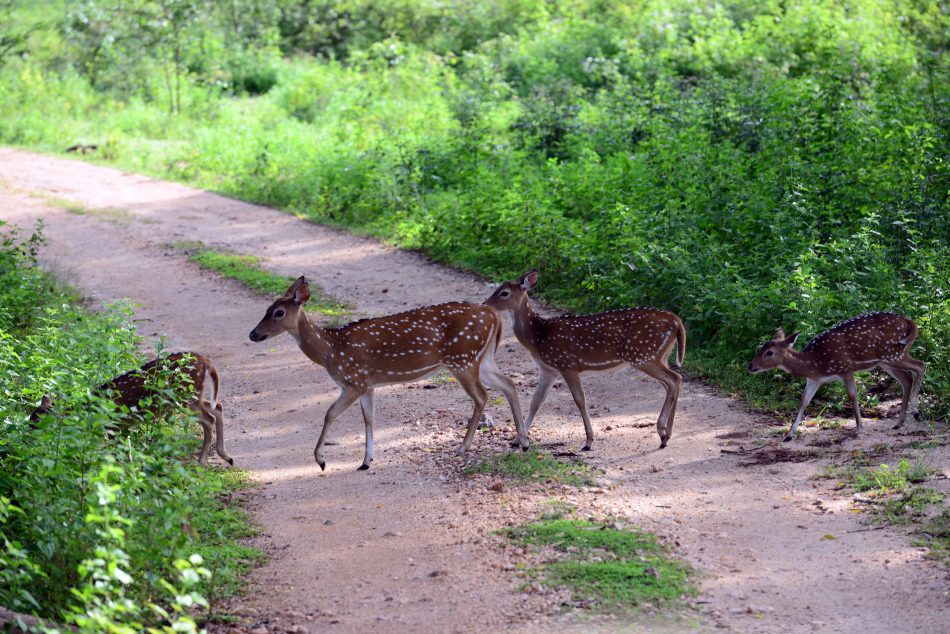 In a woodland, a group of Sri Lankan axis deer were resting under the shade. As soon as they noticed our arrival, they immediately got up and walked away one by one.
In a woodland, a group of Sri Lankan axis deer were resting under the shade. As soon as they noticed our arrival, they immediately got up and walked away one by one.
 Out of the dozen of so Sri Lankan axis deer, we only noticed one with horns.
Out of the dozen of so Sri Lankan axis deer, we only noticed one with horns.
 Once again we bumped into a Bengal monitor lizard. The one we saw was about 1.5m long.
Once again we bumped into a Bengal monitor lizard. The one we saw was about 1.5m long.
 Of course, no visit to the Udawalawe would be completed without meeting the Sri Lankan elephants.
Of course, no visit to the Udawalawe would be completed without meeting the Sri Lankan elephants.
 In both safari visits, we had seen both male and female Sri Lankan elephants of various ages and sizes.
In both safari visits, we had seen both male and female Sri Lankan elephants of various ages and sizes.
 In a group of Sri Lankan elephants, we also spotted two babies who were busy suckling milk from their mothers.
In a group of Sri Lankan elephants, we also spotted two babies who were busy suckling milk from their mothers.
 Near the end of our morning safari, we had an encounter with a large male elephant.
Near the end of our morning safari, we had an encounter with a large male elephant.
 We saw him stopping at a water pond and splashed mud water onto his body using his trunk. According to our driver, the elephant was “applying sunscreen” with the mud. Apart from sun protection, the mud also protects him from parasite. The evaporation of the mud would also cool off his skin.
We saw him stopping at a water pond and splashed mud water onto his body using his trunk. According to our driver, the elephant was “applying sunscreen” with the mud. Apart from sun protection, the mud also protects him from parasite. The evaporation of the mud would also cool off his skin.
 After exiting from the park, we passed by Udawalawe Reservoir one final time. This time, we were fortunate to see an Sri Lankan elephant bathing in the water.
After exiting from the park, we passed by Udawalawe Reservoir one final time. This time, we were fortunate to see an Sri Lankan elephant bathing in the water.


 Galle Station was first established in 1894, and has undergone an upgrade in the 20th century with a modernist concrete building.
Galle Station was first established in 1894, and has undergone an upgrade in the 20th century with a modernist concrete building. The wooden timetable at Galle Station should be an antique that has been around for decades.
The wooden timetable at Galle Station should be an antique that has been around for decades. The Coastal Line runs between Matara and Colombo Fort via Galle.
The Coastal Line runs between Matara and Colombo Fort via Galle. Taking a train in Sri Lanka is always a delightful activity and a great way to interact with the friendly locals.
Taking a train in Sri Lanka is always a delightful activity and a great way to interact with the friendly locals. Leaving Galle signified our Sri Lankan journey was coming to an end. After dinner in Colombo, we would go immediately to the airport near Negombo for our midnight flight.
Leaving Galle signified our Sri Lankan journey was coming to an end. After dinner in Colombo, we would go immediately to the airport near Negombo for our midnight flight. For the entire journey I was sitting at the opened door between two passenger train cars.
For the entire journey I was sitting at the opened door between two passenger train cars. As the snack vendor left the train, it was time for departure.
As the snack vendor left the train, it was time for departure. For the first half of the journey, the train ran along a waterfront road.
For the first half of the journey, the train ran along a waterfront road. Sitting or standing by the doorway on a Sri Lankan train is a pleasant way to enjoy the scenery. Despite the low speed of the train, certain level of caution should be taken when standing at the opened door.
Sitting or standing by the doorway on a Sri Lankan train is a pleasant way to enjoy the scenery. Despite the low speed of the train, certain level of caution should be taken when standing at the opened door.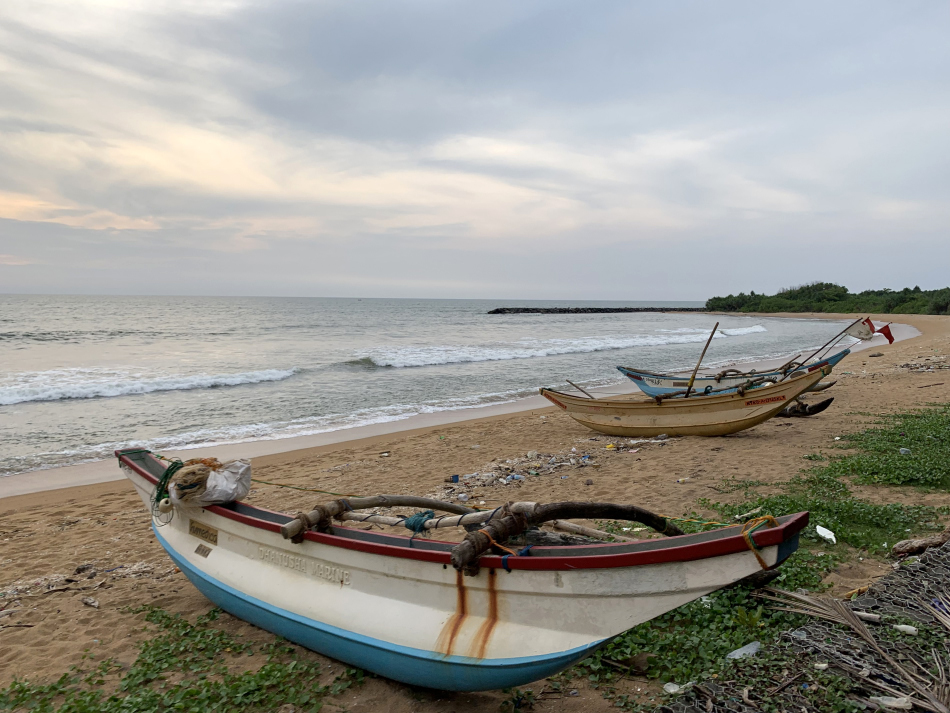 After the halfway point, the train ran right along the coastline.
After the halfway point, the train ran right along the coastline. Our train passed by a number of coastal resort towns.
Our train passed by a number of coastal resort towns. These seaside resort towns serve mainly the city dwellers from distant Colombo.
These seaside resort towns serve mainly the city dwellers from distant Colombo. We also passed by a number of impoverished communities by the sea.
We also passed by a number of impoverished communities by the sea. The train passed right in front of the houses of the seaside communities.
The train passed right in front of the houses of the seaside communities. The southwestern coast of Sri Lanka was badly hit by the 2004 Indian Ocean Tsunami. Many lives were lost and some communities have never fully recovered.
The southwestern coast of Sri Lanka was badly hit by the 2004 Indian Ocean Tsunami. Many lives were lost and some communities have never fully recovered. The Coastal Line was severely hit by the 2004 tsunami. Known as the 2004 Sri Lanka tsunami-rail disaster, a Matara Express train was running from Colombo to Galle before getting hit by the tsunami at the village of Peraliya. After two rounds of waves, the village of Peraliya was completely destroyed, and about 2000 people died (including passengers of 8 train cars and villagers who climbed onto the train top to escape the waves). Out of about 1700 train passengers, only 150 people survived. The incident is the single worst rail disaster with the largest death toll the world has ever seen.
The Coastal Line was severely hit by the 2004 tsunami. Known as the 2004 Sri Lanka tsunami-rail disaster, a Matara Express train was running from Colombo to Galle before getting hit by the tsunami at the village of Peraliya. After two rounds of waves, the village of Peraliya was completely destroyed, and about 2000 people died (including passengers of 8 train cars and villagers who climbed onto the train top to escape the waves). Out of about 1700 train passengers, only 150 people survived. The incident is the single worst rail disaster with the largest death toll the world has ever seen. The Indian Ocean offered us the perfect setting to view the sunset.
The Indian Ocean offered us the perfect setting to view the sunset. We were getting closer to Colombo as the sun was about to set below the Indian Ocean.
We were getting closer to Colombo as the sun was about to set below the Indian Ocean. After 1 hour and 45 minutes, our train was finally approaching downtown Colombo. We were ready for the final act in Sri Lanka before flying home.
After 1 hour and 45 minutes, our train was finally approaching downtown Colombo. We were ready for the final act in Sri Lanka before flying home.